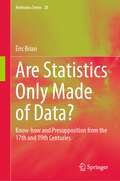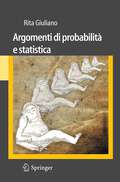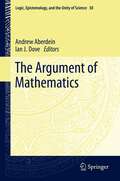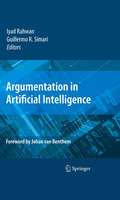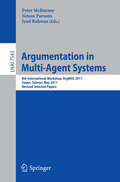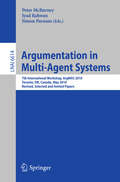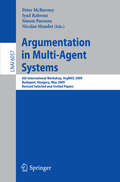- Table View
- List View
Are Statistics Only Made of Data?: Know-how and Presupposition from the 17th and 19th Centuries (Methodos Series #20)
by Éric BrianThis book examines several epistemological regimes in studies of numerical data over the last four centuries. It distinguishes these regimes and mobilises questions present in the philosophy of science, sociology and historical works throughout the 20th century. Attention is given to the skills of scholars and their methods, their assumptions, and the socio-historical conditions that made calculations and their interpretations possible. In doing so, questions posed as early as Émile Durkheim’s and Ernst Cassirer’s ones are revisited and the concept of symbolic form is put to the test in this particular survey, conducted over long period of time. Although distinct from a methodological and epistemological point of view, today these regimes may be found together in the toolbox of statisticians and those who comment on their conclusions. As such, the book is addressed to social scientists and historians and all those who are interested in numerical productions.
Area of a compound shape (large print)
by RnibThis page shows a small diagram. There is a locator dot shown, which will be at the top left, when the image is the correct way up.
Area of a compound shape (UEB contracted)
by RnibThis page shows a small diagram. There is a locator dot shown, which will be at the top left, when the image is the correct way up. The shape comprises two rectangles joined together. The sides are labelled with their length in centimetres. How to calculate the area of the shape is explained just down from the shape.
Area of a compound shape (UEB uncontracted)
by RnibThis page shows a small diagram. There is a locator dot shown, which will be at the top left, when the image is the correct way up. The shape comprises two rectangles joined together. The sides are labelled with their length in centimetres. How to calculate the area of the shape is explained just down from the shape.
Area of a parallelogram (large print)
by RnibThis page shows a simple shape. There is a locator dot shown, which will be at the top left, when the image is the correct way up. The parallelogram with its height and base labelled in centimetres is in the middle of the page. The generic formula for working out the area of a parallelogram is given. The calculation for the area of this parallelogram is at the bottom of the page.
Area of a parallelogram (UEB contracted)
by RnibThis page shows a simple shape. There is a locator dot shown, which will be at the top left, when the image is the correct way up. The parallelogram with its height and base labelled in centimetres is in the middle of the page. The generic formula for working out the area of a parallelogram is given. The calculation for the area of this parallelogram is at the bottom of the page.
Area of a parallelogram (UEB uncontracted)
by RnibThis page shows a simple shape. There is a locator dot shown, which will be at the top left, when the image is the correct way up. The parallelogram with its height and base labelled in centimetres is in the middle of the page. The generic formula for working out the area of a parallelogram is given. The calculation for the area of this parallelogram is at the bottom of the page.
Area of a trapezium (large print)
by RnibThis page shows two simple shapes. There is a locator dot shown, which will be at the top left, when the image is the correct way up. The trapezium at the top of the page has its dimensions labelled with letters. These are referred to in the formula just up from the trapezium. This is the generic formula for working out the area of a trapezium. A second trapezium is at the bottom of the page, labelled with dimensions in metres. The calculation for the area of this trapezium is at the bottom of the page.
Area of a trapezium (tactile)
by Sheffield Vi ServiceThis is a labelled diagram showing how the area of a trapezium is calculated.
Area of a trapezium (UEB contracted)
by RnibThis page shows two simple shapes. There is a locator dot shown, which will be at the top left, when the image is the correct way up. The trapezium at the top of the page has its dimensions labelled with letters. These are referred to in the formula just up from the trapezium. This is the generic formula for working out the area of a trapezium. A second trapezium is at the bottom of the page, labelled with dimensions in metres. The calculation for the area of this trapezium is at the bottom of the page.
Area of a trapezium (UEB uncontracted)
by RnibThis page shows two simple shapes. There is a locator dot shown, which will be at the top left, when the image is the correct way up. The trapezium at the top of the page has its dimensions labelled with letters. These are referred to in the formula just up from the trapezium. This is the generic formula for working out the area of a trapezium. A second trapezium is at the bottom of the page, labelled with dimensions in metres. The calculation for the area of this trapezium is at the bottom of the page.
Area of a triangle (large print)
by RnibThis page shows a small diagram. There is a locator dot shown, which will be at the top left, when the image is the correct way up. There is a diagram of a triangle and the equation for finding the area is written next to it.
Area of a triangle (UEB contracted)
by RnibThis page shows a small diagram. There is a locator dot shown, which will be at the top left, when the image is the correct way up. There is a diagram of a triangle and the equation for finding the area is written next to it.
Area of a triangle (UEB uncontracted)
by RnibThis page shows a small diagram. There is a locator dot shown, which will be at the top left, when the image is the correct way up. There is a diagram of a triangle and the equation for finding the area is written next to it.
Area of irregular shapes (large print)
by RnibThis page shows two square diagrams. There is a locator dot shown, which will be at the top left, when the image is the correct way up. There is a different irregular shape in each diagram. They have a grid of twenty five squares marked out by dashed lines on each of them. Counting the squares helps estimate the area of the irregular shape.
Area of irregular shapes (UEB contracted)
by RnibThis page shows two square diagrams. There is a locator dot shown, which will be at the top left, when the image is the correct way up. There is a different irregular shape in each diagram. They have a grid of twenty five squares marked out by dashed lines on each of them. Counting the squares helps estimate the area of the irregular shape.
Area of irregular shapes (UEB uncontracted)
by RnibThis page shows two square diagrams. There is a locator dot shown, which will be at the top left, when the image is the correct way up. There is a different irregular shape in each diagram. They have a grid of twenty five squares marked out by dashed lines on each of them. Counting the squares helps estimate the area of the irregular shape.
Area of shapes (tactile)
by Adrian FarnsworthThese three pages each show a different shape and the formula needed to calculate its area.
Areas - trapezium (tactile)
by RnibThis diagram shows a trapezium with 3 parts labelled with arrows. The height is labelled h, the top length is labelled a and the bottom length is labelled b. These lengths allow you to work out the area of the shape.
Argomenti di probabilità e statistica
by Rita GiulianoIl volume presenta le nozioni fondamentali del Calcolo delle Probabilità e della Statistica, così come di solito vengono insegnate nei corsi presenti nelle Lauree Triennali di indirizzo scientifico. La scelta degli argomenti e la loro presentazione rispecchiano la notevole esperienza didattica acquisita dall'autrice, che da molti anni è docente in questo tipo di corsi, e di conseguenza il suo modo di porgere la materia. Il principale obiettivo del testo è quello di aiutare il lettore a padroneggiare la disciplina limitando per quanto possibile gli strumenti tecnici; ciò dovrebbe consentire ad uno studente, anche di non elevata preparazione matematica, di apprendere comunque senza troppa difficoltà i concetti di base. L'autrice si è soffermata in modo particolare sulle motivazioni che portano ad introdurre le varie nozioni e su alcuni punti che in genere gli studenti trovano di difficile comprensione.
The Argument of Mathematics (Logic, Epistemology, and the Unity of Science #30)
by Andrew Aberdein and Ian J DoveWritten by experts in the field, this volume presents a comprehensive investigation into the relationship between argumentation theory and the philosophy of mathematical practice. Argumentation theory studies reasoning and argument, and especially those aspects not addressed, or not addressed well, by formal deduction. The philosophy of mathematical practice diverges from mainstream philosophy of mathematics in the emphasis it places on what the majority of working mathematicians actually do, rather than on mathematical foundations.The book begins by first challenging the assumption that there is no role for informal logic in mathematics. Next, it details the usefulness of argumentation theory in the understanding of mathematical practice, offering an impressively diverse set of examples, covering the history of mathematics, mathematics education and, perhaps surprisingly, formal proof verification. From there, the book demonstrates that mathematics also offers a valuable testbed for argumentation theory. Coverage concludes by defending attention to mathematical argumentation as the basis for new perspectives on the philosophy of mathematics.
Argumentation in Artificial Intelligence
by Iyad RahwanArgumentation is all around us. Letters to the Editor often make points of cons- tency, and “Why” is one of the most frequent questions in language, asking for r- sons behind behaviour. And argumentation is more than ‘reasoning’ in the recesses of single minds, since it crucially involves interaction. It cements the coordinated social behaviour that has allowed us, in small bands of not particularly physically impressive primates, to dominate the planet, from the mammoth hunt all the way up to organized science. This volume puts argumentation on the map in the eld of Arti cial Intelligence. This theme has been coming for a while, and some famous pioneers are chapter authors, but we can now see a broader systematic area emerging in the sum of topics and results. As a logician, I nd this intriguing, since I see AI as ‘logic continued by other means’, reminding us of broader views of what my discipline is about. Logic arose originally out of re ection on many-agent practices of disputation, in Greek Ant- uity, but also in India and China. And logicians like me would like to return to this broader agenda of rational agency and intelligent interaction. Of course, Aristotle also gave us a formal systems methodology that deeply in uenced the eld, and eventually connected up happily with mathematical proof and foundations.
Argumentation in Multi-Agent Systems: 8th International Workshop, ArgMAS 2011, Taipei, Taiwan, May 2011, Revised Selected Papers (Lecture Notes in Computer Science #7543)
by Peter McBurney Simon Parsons Iyad RahwanThis book constitutes the thoroughly reviewed post-proceedings of the 8th International Workshop on Argumentation in Multi-Agent Systems, ArgMas 2011, held in Taipei, Taiwan in May 2011 in association with the 10th International Conference on Autonomous Agents and Multi-Agent Systems (AAMAS 2011). The 8 revised full papers taken from ArgMAS 2011. Also included are 5 invited papers based on presentations on argumentation at the AAMAS 2011 main conference. All together the 13 papers included in the book give a representative overview on current research on argumentation in multi-agent systems. The papers are listed alphabetically by first author within three thematic topics: foundations and theory; argumentation and dialogue; and applications.
Argumentation in Multi-Agent Systems: 7th International Workshop, ArgMAS 2010, Toronto, Canada, May 10, 2010, Revised Selected and Invited Papers (Lecture Notes in Computer Science #6614)
by Peter McBurney Iyad Rahwan Simon D. ParsonsThis book constitutes the thoroughly reviewed post-proceedings of the 7th International Workshop on Argumentation in Multi-Agent Systems, ArgMas 2010, held in Toronto, Canada in May 2010 as a satellite workshop of AAMAS 2010.The 14 revised full papers taken from ArgMAS 2010 were carefully reviewed and improved during two rounds of revision. Also included are 4 invited papers based on presentations on argumentation at the AAMAS 2010 main conference. All together the 18 papers included in the book give a representative overview on current research on argumentation in multi-agent systems. The papers are organized in topical sections on practical reasoning and argument about action, applications, and theoretical aspects.
